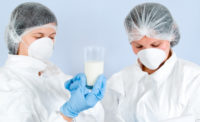The importance of visibility from farm to table

Food quality matters, and not simply to ensure freshness. Customers want to know where their food comes from as much as you do.
But, in the journey from farm to table, it’s easy to lose sight of all the things that take place in between. That’s because it rarely is just farm to table. It’s more like farm to factory to distribution center to retailer to refrigerator to table, with a few other steps in between.
Because the supply chain is often much longer than we’d like customers to believe it is, the only way to ensure food quality is to make sure you can see it all the way from the farm to the table. That kind of quality is something customers are willing to pay a premium for.
When a disruption such as a product recall or supplier issue takes place, it has a long-tail effect on the entire supply chain. Doing reverse forensics to figure out where a problem originated costs time and money. It reneges on that promise of delivering fresh, high-quality food. That’s in part because of the fragmented nature of the systems many businesses use to manage supply chain processes today.
Traditional enterprise resource planning software (ERP) is popular for a reason. It does a great job helping businesses control many of the manufacturing processes that take place within the enterprise, such as scheduling, order processing, warehousing and managing workflow. And, while that’s traditionally worked just fine, most brands are more than what is inside the four walls.
It’s rare to find a national or international brand that owns its entire supply chain from farm to table. Food manufacturing is much more distributed than that. Most companies rely on third parties for a significant portion–if not all–of the manufacturing process. It adds up to many independent parties using their own, often different, enterprise solutions to manage their portions of production and then handing it off to the next provider in line. You can’t fault companies for interacting this way–to a large extent, it works. But, it also introduces the opportunity for error, as disparate systems and blind handoffs give way to certain levels of uncertainty as to what exactly is taking place.
Some of the leaders in the industry have come around to the idea that traditional ERP is not enough to provide end-to-end visibility into the entire food manufacturing supply chain. Del Monte Foods, with headquarters in Walnut Creek, Calif., and Pittsburgh, Pa., is one example. The producer, distributor and marketer of packaged fruits and vegetables supplements its SAP software with a separate, cloud-based platform that helps extend the ability to see across its supply chain and collaborate with partners.
“Our enterprise supply chain strategy requires seeing well beyond the walls of our business into the supply network,” says Mitch Hunter, Del Monte’s director of supply chain.
Business software in a cloud environment, or a commerce cloud, can provide the connective tissue to integrate a manufacturer with its suppliers further downstream. This becomes the foundation in establishing multi-enterprise visibility. Visibility into suppliers’ businesses and practices enables traceability and transparency, which have been elusive to manufacturing to this point, and growing even more so as more business is outsourced.
Del Monte moved its supply chain to the cloud to better address the complexities of operating a global brand. Using this always-connected technology, the company can access demand signals, create order and shipment plans, contract with suppliers, confirm shipments, control inventory, generate invoices, handle discrepancies and collaborate with its network of trading partners. The result of this transformation is a 56% savings in customs broker costs and better visibility outside of the four walls. Del Monte also reduced its inventory levels by about 26% because it grasped a better handle on goods in transit.
Just as ERP solutions provide a system of record for operations within the four walls of the business, a cloud network can extend that functionality into the supply chain. The same level of control and visibility achieved within the four walls can be deployed externally with trading partners. This is where steps and precautions around quality, materials and ingredients can be deployed. This scenario enables the manufacturer to hold itself and its suppliers more accountable. It allows them to go on offense to prevent recalls and ensure quality. And in the event of a recall, the impacted product is identified and pulled faster and more accurately.
In the highly constrained and tightly regulated world of food manufacturing, companies can’t afford to be uncertain about the products they sell, especially when quality, safety and customer loyalty are on the line. Visibility across the entire supply chain is a big step toward delivering that farm to table experience customers demand.
Looking for a reprint of this article?
From high-res PDFs to custom plaques, order your copy today!





